About Emergency Alerts
Emergency Alerts keep you safe in life-threatening situations.
They’re sent by the UK Government or emergency services to warn you about severe flooding, fires, extreme weather, or other major incidents. Alerts appear on your phone’s screen with a loud siren sound and vibration, even if your phone is on silent. You don’t need an app, and the service is free.
Emergency Alerts and how you receive them
Emergency Alerts are a public information system that we have developed to alert citizens to emergencies, both nationwide and in their local area, that represent a severe threat to life and/or property. The technology used allows a message to be broadcast to a defined area, meaning any compatible device in or entering that area will immediately receive the message, detailing the emergency and actions people need to take to ensure their safety. Compatible devices are iPhones made after 2015 with the latest software, and Android phones and tablets that are made after 2015 and have the latest software. All devices need to be 4G or 5G compatible. Phones purchased new since summer 2021 will have the software automatically activated.
Their purpose is to help save lives in emergency situations by issuing a warning and clear instructions about how best to respond. While the alert service will initially be used as part of our severe flood warning response service, it could also serve a wider purpose and be used as an emergency response for other scenarios, such as public health emergencies, fires, extreme weather and major incidents. Emergency Alerts are our way of warning people when lives are in danger.
Alerts are broadcasted via mobile phone cell towers to specific geographical areas. You do not need to modify location settings on your phone to receive them, and switching off location settings will not affect your ability to receive them.
What is an Emergency Alert test
The Government announced the Emergency Alerts system on 17 May 2021 with a Written Ministerial Statement. This was followed by a successful live test of both the alert system and localised communications in East Suffolk on 25 May 2021 and a much larger test across all of Reading on 29 June 2021.
When you receive a test alert, you will not need to do anything. To learn more about Emergency Alerts, look out for the nationwide information campaign or visit https://www.gov.uk/alerts
What do the messages look like and sound like?
Emergency Alerts appear on your device's home screen. You have to acknowledge them before you can use your phone’s other features. They appear as a notification and may include telephone numbers or website links containing further information. A loud, siren-like sound and vibration will accompany the message to raise awareness of the hazard or threat.
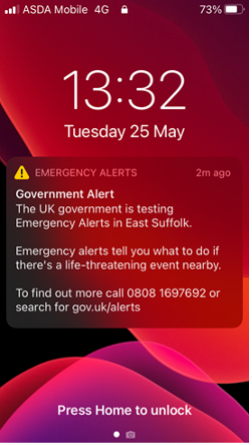
What should I do when I receive an Emergency Alert?
Read the content carefully. An Emergency Alert is likely to include a link to gov.uk/alerts where further information is contained, and/or a helpline. Alerts are sent to warn you when lives are in danger, and potentially, in some cases, for test purposes. Take the appropriate action as directed and consider alerting others in the area who may not have received or seen the message.
What if I receive a message while driving?
You MUST NOT hold a mobile phone while driving or riding a motorcycle. It is illegal to do so. You must have hands-free access, such as voice command, a dashboard holder or mat, or a windscreen mount, and the device must not block the driver’s view of the road or the traffic. You should not read or otherwise respond to an emergency alert whilst driving or riding a motorcycle. For more information on the latest legislation around driving and using a mobile phone, follow this link for more advice: https://www.gov.uk/using-mobile-phones-when-driving-the-law.
Please be aware that the alert will appear on your device until acknowledged, and you will hear a loud siren-like sound for up to 10 seconds. If you are driving, continue driving and do not respond to the noise; do not pick up the mobile phone to deal with the message. Instead, find a safe, legal place to stop before reading the message. If there is nowhere safe or legal to stop close by, and nobody else is in the vehicle to read the alert, tune into live radio, and wait for bulletins until you can find somewhere safe and legal to stop.
You must stay in complete control of your vehicle at all times. The police can stop you if they think you are not in control because you are distracted, and you can be prosecuted. The law still applies if you are stopped at traffic lights, queuing in traffic or supervising a learner driver. You can, however, use a hand-held mobile phone if either you are safely parked or need to call 999 or 112 in an emergency, and it is unsafe or impractical to stop.
Why are you not using SMS?
Emergency Alerts offer a number of advantages over SMS:
- Speed of delivery - After the alert is sent from the issuing authority, the public should receive the message in about 4 to 10 seconds. SMS messages can take days to release when sent to the entire population and will not be received by those from outside the UK.
- Targeting of messages - Emergency Alerts allow a message to be broadcast to a defined area, meaning any compatible device in or entering that area immediately receives the message.
- Security - the public can be fully confident that only authorised organisations are able to send these Emergency Alert messages.
- Privacy concerns - No personal information (such as telephone number, identity or location) is used in the sending of these alerts.
- Effectiveness - the messages use a distinct tone and vibration that is hard to ignore and conveys urgency. The messages are designed to encourage recipients to act.
- Future proofed - Emergency Alerts align to international standards, so your phone will warn you of danger if you are in one of the 20 other countries which use them.
- Impact on the mobile network - The resources required to send a message are minimal, creating no network congestion for mobile networks.
Is my privacy and security protected?
Emergency Alerts require no personal information (such as telephone number, identity or location). The technology used allows a message to be broadcast to a defined area, meaning any compatible device in or entering that area immediately receives the message. Emergency alerts are therefore one-way and do not provide any feedback on the recipients’ location or whether they have received an alert. The recipients’ telephone numbers and specific locations are not required, known or used, and no personal information on recipients of Emergency Alerts is shared by the Mobile Network Operators and no personal information is gathered by the government or the Mobile Network Operators.
Will alerts sent to my mobile phone tell authorities where I am or be used to gather data about me?
Emergency Alerts are one-way and do not provide any feedback on your location or whether you have received an Emergency Alert. No data is being gathered about you, your phone or your location. No personal information is gathered by the government or the Mobile Network Operators on recipients of Emergency Alerts.
Will all the Mobile Networks provide Emergency Alerts?
Emergency Alerts will be sent across all mobile networks, including the mobile virtual networks (e.g. Asda, Lebara, GiffGaff) which have previously been left out of nationwide-SMS messages.
Do I need to download an app?
Emergency Alerts do not require an App to be downloaded. However, depending on your device you may need to download the latest software to ensure your device can receive the Alerts.
Is it used elsewhere?
Emergency Alerts have been adopted by many countries internationally as an alerting capability. These countries include the USA, Netherlands, Canada, New Zealand, South Korea and Japan.
Will Emergency Alerts be available in Wales, Scotland and Northern Ireland?
Emergency Alerts will be available in England, Scotland and Wales. The rollout in Northern Ireland is planned for later this year.
Is there a charge to receive an Emergency Alert?
There are no charges to receive Emergency Alerts. Alerts are sent on a specific channel that is separate from normal text and data traffic. While the alerts may look like text messages, they are not and will not be charged to your bill like text messages. Additionally if you use Pay-As-You-Go and find yourself out of credit, you will still receive alerts.
Will this new service affect my battery life?
Neither Emergency Alerts nor leaving the ability to receive them on in your phone settings will impact your phone’s battery life. Most people will receive them infrequently- beyond the National Welcome Message it would be rare for anyone to receive more than one per year.
Can I reply to an Emergency Alert?
The messages are one-way only. Check the contents of the message for links to further information on GOV.UK or contact numbers.
What languages will messages be broadcast in?
The primary language will be English. Sending dual language English/Welsh messages is also possible for alerts in Wales. We will continue to investigate the use of the technology for messages sent in other languages to increase the effectiveness and reach of the service.
How many people will it reach?
We want to make sure these alerts reach as many of the target population as possible. Anyone with a compatible device in the targeted region will receive the alerts. Our research estimates that nearly 90% of mobile handsets will receive the emergency alert sent out for the National Welcome Message.
Will Emergency Alerts work on all devices?
Emergency Alerts should be received on the majority of mobile handsets. However, there are some factors which might mean you will not receive an alert. These include:
- When a handset connects to 3G or a 2G signal. A device needs to be on 4G or 5G to receive the alert.
- When a handset does not have the latest software update or the software update has not been released (older devices have a slower update cycle). This will not be possible if the device is no longer supported with updates and will therefore be unable to receive alerts.
- The handset is not a 4G/5G-enabled device or has been locked to 3G or 2G/3G only.
- The handset was switched off or in airplane/ flight mode.
- The handset was not connected to a mast broadcasting the Emergency Alert. However, if the device connects to a mast which is broadcasting before the alert is cancelled, it will receive the alert and show it to its use.
For hand-held tablets, iPads cannot currently receive alerts unless connected to an iPhone. 4G/5G-enabled tablets that support a SIM can receive alerts. Some Apple Watches will receive alerts depending on whether they are paired with a phone.
Do I need to update my phone to receive Emergency Alerts?
If it does not have the latest software. Most newer phones (from 2015 onwards) can receive the messages if they have the latest software update. Phones over 6 years old will probably require some changes to the settings by the user as has been the experience in other countries, but some may not be adaptable. Older models of Apple (before iPhone 6S) that do not support iOS 14 and older models of Android (generally older than Android 9 / Pie) will not be able to receive Emergency Alerts.
How do I check if my phone is compatible?
The following options will be visible when you update your phone to the latest software.
For iPhones:
- Open Settings
- Select Notifications
- Make sure the “Emergency Alerts” toggle is on
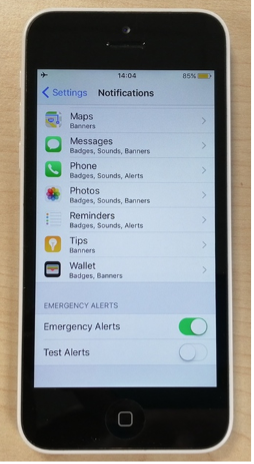
For Samsung phones:
- Individual phones may vary, depending on which software version a customer is on.
- Android 11: Settings > Search for “emergency alerts” OR Settings > Notifications > Advanced Settings > Emergency Alerts
- Android 10 and older OS versions: Messages app > Settings > Emergency Alert settings > Emergency Alerts
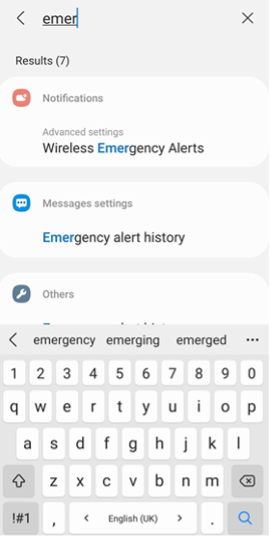

For other Android Phones:
The Emergency Alert settings are dependent on the manufacturer and model. Generally the settings can be found through one of the following ways:
- Open Settings, select Sounds and select Advanced. You should see an option for Emergency Broadcasts
- Open Settings, select Wireless & Networks and select More. You should see an option for Cell Broadcasts
- Open Settings and select General Settings. You should see an option for Emergency Alerts
- Open the text message app and select Message Settings. You should see an option for Emergency Alert Settings
- Your alert settings may be called a number of different names including: Emergency Alerts, emergency broadcasts, or extreme threats or severe threats
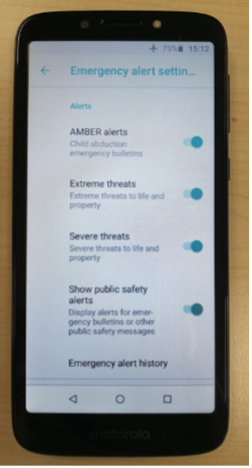
For Huawei phones:
Individual phones may vary, depending on which software version a customer is on. Please note that Emergency Alerts are turned on by default
- EMUI 12: Settings > Search for “emergency alerts” OR Settings > Sounds & vibration > More settings > Cell broadcasts. Make sure the “Emergency Alerts” toggles are on
- EMUI 11 and older OS versions: Settings > Search for “emergency alerts” OR Settings > Sounds & vibration > More settings > Cell broadcasts. Make sure the “Extreme threats” and “Severe threats” toggles are on
What if my phone can’t receive Emergency Alerts?
Emergency Alerts are just one of many tools the Government has to communicate with the public about emergency situations. The service will be one source of information in the event of a life-threatening emergency. Existing procedures will still be in place, so those without a mobile will still be made aware through the news and local emergency services, for example.
As part of the public information campaign, we are working closely with community leaders and stakeholders to ensure that those communities and people who are less likely to have a 4G/5G capable device (notwithstanding tables) will be able to access the information distributed through the alerts. We advise anyone who does not have a 4G/5G capable device to identify someone who lives near them who will be able to inform them of any Emergency Alerts being sent.
Does it matter what network my phone is on?
Emergency Alerts will be sent across all networks, as well as subsidiary ‘Mobile Virtual Network Operators’ such as Lebara, Giff Gaff and Tesco Mobile.
Are you using all the network types, like 2G, 3G, 4G and 5G?
The initial roll out will be on devices that use 4G and 5G network (with the exception of tablets).
Our research indicates that nearly 90% of mobile handsets will be able to receive the alerts. We recognise that leaves some phones unable to receive them, however with the planned switch-off of 2G and 3G, we expect this percentage to rise as customers switch to newer handsets. Our communications campaign will stress the importance of knowing whether your phone can receive them as well as looking out for those who do not. Ultimately this should be considered one channel over which information will be passed- in the event of a crisis numerous other channels will also be used which may be more accessible to those with older handsets.
What sort of Emergency Alert might I receive?
During the initial pilot phase, alerts will be limited to extreme weather events ike flooding. Future messages are expected to include these as well as fires, public health emergencies and other life-threatening or major incidents.
How frequently might I get them?
The likelihood of receiving a message in any given year is low. The most frequent use is expected to be for flooding, but frequency depends on your personal proximity to threats.
I am a domestic abuse victim and need to conceal my phone. How can I stop it from going off?
It is possible to opt out of the system if you need your phone to stay concealed.
After the test, once Emergency Alerts are fully operational their use cannot be predicted as they will be used in emergencies. The choice is yours, but we strongly recommend that people do not opt out of the service, as it is intended to warn you when lives are in danger.
Can I opt out?
Members of the public can opt out of receiving all emergency alerts. To do so, search for emergency alerts in your phone’s settings. It is not possible to opt out of alerts by type of hazard, for example, only receiving messages about flooding but not for industrial accidents.
We strongly recommend that people not opt out of the service, as it is intended to warn you when lives are in danger. It is possible to opt out, but we would encourage you not to. See this Government website for more details.
Android phones and tablets
- To opt out, search your settings for ‘emergency alerts’ and turn off Severe alerts and Emergency alerts
- If this does not work, contact your device manufacturer
Mobile network operator tests:
- To opt out of mobile network operator tests, search your settings for ‘emergency alerts’ and turn off Test alerts
iPhone:
- To opt out, search your settings for ‘emergency alerts’ and turn off Severe alerts and Emergency alerts
- If this does not work, contact your device manufacturer
- For further advice go to gov.uk/alerts/opt-out
Android phones and tablets:
- To opt out, search your settings for ‘emergency alerts’ and turn off Severe alerts and Emergency alerts.
- On Huawei devices running EMUI 11 or older, search your settings for ‘emergency alerts’ and please turn off “Extreme threats”, “Severe threats” and “Show amber alerts”
- If this does not work, contact your device manufacturer
If I’m on a call or using my phone, like watching a video or using Facebook when an Emergency Alert is sent, will I receive it?
You you will receive the Emergency Alert no matter what you are using your phone for.
Will I receive a message if I am using my phone as a sat-nav system?
An Emergency Alert will display as a message if a user is using an App e.g. maps for navigation. See below for an example of how this appears:
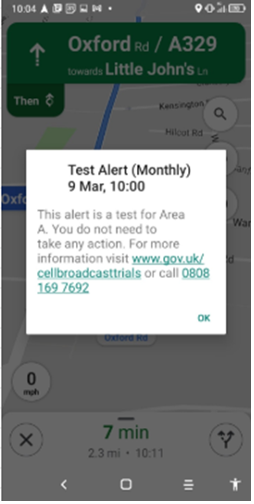
How will I know that the alert is genuine and not a scam to get me to do something (i.e. leave my house for my own ‘personal safety’)?
An Emergency Alert looks and sounds very different to other types of messages such as SMS ‘text messages’. You’ll know if you get an Emergency Alert because you’ll hear a loud, siren-like sound and your phone will use a distinct vibration. You have to acknowledge them before you can use your phone’s other features. They appear as a notification and may include a phone number or a link to gov.uk/alerts , where you’ll also be able to check that an alert is genuine.
If you receive an alert but are still in doubt about the origins of the message, go to gov.uk/alerts or contact neighbours, friends or family in the nearby area to check whether they have received it too.
You can validate that an alert is real by going to gov.uk/alerts- legitimate alerts will always be uploaded here so you can check whenever you receive one.
If you believe you have received a scam SMS text, report it by forwarding it to 7726. Do not click on any links in the SMS text message. You will not be able to forward a genuine Emergency Alert message.
If you or someone you know has been the victim of fraud or cybercrime you can report it to Action Fraud at www.actionfraud.police.uk or by phoning 0300 123 2040. In Scotland, you can report it by dialling 101.
Can I trust the phone numbers and website links in the messages?
Emergency Alerts may include a phone number or a link to gov.uk/alerts where further information will be available. Emergency alerts can only be sent by emergency responders or the Government.
What time will Emergency Alerts arrive?
Where possible, messages will be sent out during normal waking hours. However there may be situations where messages need to be sent overnight (for example for severe flooding) where it is vital to inform you as soon as possible. A public test of the system will never be carried out overnight.
What happens if my device is in airplane/ flight mode, turned off or out of battery?
In this case you will not receive an alert. However, once your phone has power, is switched on and connected to the network, it will receive the Emergency Alert assuming it is being broadcast at that time and the threat has not passed.
Will my 4G/5G enabled tablet receive the messages?
For hand-held tablets, IPads cannot currently receive alerts unless connected to an iphone. 4G/5G-enabled tablets that support a SIM can receive alerts. Some Apple Watches may receive alerts depending on whether they are attached to a phone or not.